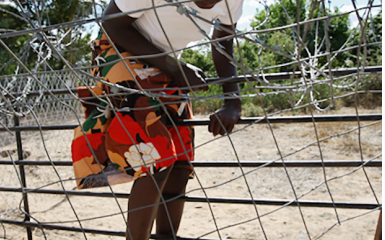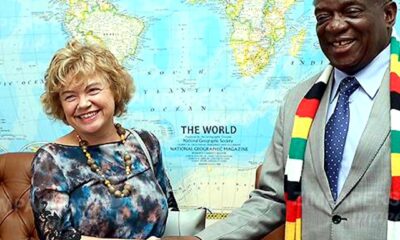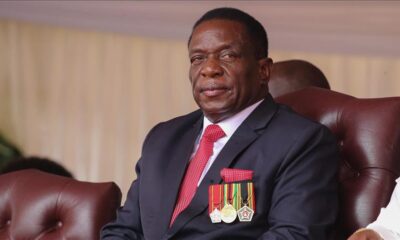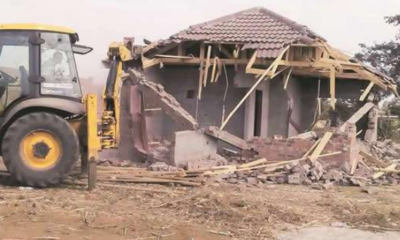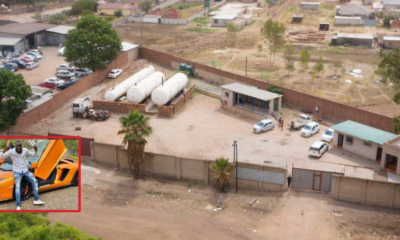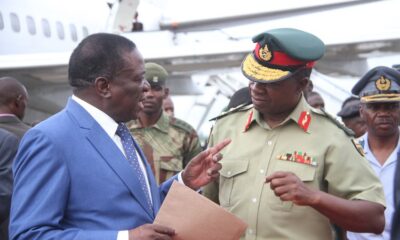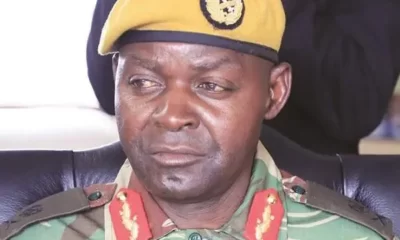
Opinion
Hate speech: the trigger and fuel of violent atrocity
Published
3 years agoon
By
NewsHawksBy Siphosami Malunga
I want to express my profound gratitude to the organisers for the honour and privilege granted to me to deliver the 2020 annual lecture under the theme: Hate Speech and its Impact on Transitional Justice. I feel scarcely qualified to do so but will endeavour to do justice to the honour.
This is not my first time to be invited to speak by the National Transitional Justice Working Group. I had the privilege to share remarks on prospects for accountability for Gukurahundi atrocities in Matopo and in the vicinity of Bhalagwe Detention Camp in 2018 at the annual meeting of the Working Group. It now seems like a lifetime away. A lifetime in which much has happened without much seeming to have changed.
What is hate speech?
Of all the words in the dictionary, I hate the word hate the most. It is a strong word. It is a terrible word. To hate it feel an intense dislike for something. Synonyms for the term are equally unnerving and include dislike, abhor, loathe and detest. Hate has also been described as intense hostility and aversion usually deriving from fear, anger, or sense of injury. It has also been described as extreme dislike or disgust of something or someone.
Hate speech should, therefore, be understood in the context of the description and meaning of the word hate. Hate is rarely unfounded. It is often derived from somewhere or something. It may be rooted in a historical experience or real or unfounded fear, anger or sense of injury or injustice. It can be generated, instigated, propagated and encouraged. It is the drivers of hate—human and social—that must never be ignored. It is never a spontaneous feeling. Hate is the opposite of love: which is an intense feeling of affection. The contrast could not be more powerful and is captured by Martin Luther, who said that:
“I have decided to stick to love; hate is too great a burden to bear.
That hate is never spontaneous was aptly described by Nelson Mandela, who said:
No one is born hating another person because of the colour of his skin, or his background, or his religion. People must learn to hate, and if they can learn to hate, they can be taught to love, for love comes more naturally to the human heart than its opposite.”
So that is the definition of hate. But what is the definition of hate speech? It may surprise to know that for a term we readily deploy to described everyday utterances, there is no universal legal definition of hate speech. The term itself is controversial. It may again surprise you to know that hate speech legislation has its origins not in the liberal post-Second World War anti-semitic paradigm but instead in the reactionary, counter-revolutionary politics of Prussia in the 1790s. Essentially the penalisation of speech that was considered to be hateful was first used by authoritarian monarchies seeking to stem liberal criticism. The shift towards a human rights orientation of hate occurred in the context of the push back against antisemitism and the rise of liberalism and the essentialisation of non-discrimination as a critical value of democracies.
The term hate speech has been described by the United Nations in its 2019 Strategy and Plan to Address Hate Speech as:
“Any kind of communication in speech, writing or behaviour, that attacks or uses pejorative or discriminatory language with reference to a person or a group on the basis of who they are, in other words, based on their religion, ethnicity, nationality, race, colour, descent, gender or other identity factor. This is often rooted in, and generates intolerance and hatred and, in certain contexts, can be demeaning and divisive.”
The prohibition of hate speech by international law has its origins in the prohibition of discriminatory conduct, policy and practice. The most prominent example is the UN condemnation of speech “based on ideas or theories of superiority of one race or group of persons of one colour,” in the International Convention on the Elimination of All Forms of Racial Discrimination of 1965 based on which apartheid was criminalised as a crime against humanity.
Why and how is hate speech dangerous?
Some people may ask: why and how is hate speech dangerous, especially when free speech is protected? Why is some speech considered hate speech? After all, everyone has a right to hold and express their opinion. Every Constitution, including the Zimbabwean one, guarantees that right. Why censor free speech by calling it hate speech? The simple answer is that the right to free speech like all other rights is that rather than criminalise or prohibit hate speech, international law prohibits the incitement to discrimination, hostility and violence (referred to here as ‘incitement’).
Incitement is a very dangerous form of speech because it explicitly and deliberately aims at triggering discrimination, hostility and violence, which may also lead to or include terrorism or atrocity crimes. Hate speech that does not reach the threshold of incitement is not something that international law requires States to prohibit. It is important to underline that even when not prohibited, hate speech may to be harmful.
We only have to look at history to understand the role that hate speech has played in inciting violence and atrocity. Although I have been asked to focus on Zimbabwe, I will draw on three international examples in addition to Zimbabwe to demonstrate the link between hate speech and violence namely: the Nazi Holocaust, the Rwandan Genocide, the Gukurahundi Atrocities and the more recent Xenophobic Violence in South Africa.
The Nazi Holocaust in Germany and Europe in 1941-45 resulted in the death of 6 million Jews. A critical factor in the extermination of the Jews was a widespread and virulent anti-Semitic campaign—hate speech—in Germany and Europe which preceded and accompanied the widespread atrocities. Founder and publisher of the virulently anti-Semitic newspaper Der Stürmer publisher Julius Streicher and Nazi Minister of Propaganda Josef Goebbels played a leading role in the virulent campaign advocating for discrimination and extermination of Jews.
In Rwanda, 800 000 Tutsis and moderate Hutus were massacred in a genocide in the space of 100 days in 1994. Hate speech, propagated through a variety of media including by senior political, religious, business and societal leaders played a significant role in mobilising Hutu citizens to take up arms and kills Tutsis and moderate Hutus. A leading radio station, RTLM and a national newspaper were especially instrumental in advocating violence against Tutsi citizens identifying, publicising their locations and encouraging their massacre. In Rwanda, Tutsis were referred to as cockroaches that had to be killed.
In Zimbabwe, between 1983 and 1987, the Gukurahundi was deployed to Matabeleland and the Midlands to ostensibly deal with dissidents. Instead, it committed widespread atrocities against civilians, resulting in the deaths of an estimated 20 000 civilians. Hate speech by senior political leaders including the Prime Minister, Home Affairs, Defence and Security Minister was instrumental in encouraging the atrocities committed by a range of perpetrators including members of the 5 Brigade, Central Intelligence Organisation, police, and Zanu PF youth militia. The then Prime Minister, Robert Mugabe, labelled supporters of the opposition party Zapu as snakes and the leader of the party, Joshua Nkomo as the “head of the snake that needed to be crushed”. The minister of State Security, Emmerson Mnangagwa, were referred to Zapu supporters as cockroaches that had to be exterminated using DDT (pesticide). There was a direct correlation between the widely spread and systematic nature of the attacks on civilians and the tacit encouragement, demonisation and dehumanisation of the victims of the Gukurahundi genocide.
In 1990, during the election, hate speech by President Robert Mugabe, senior leaders in government and Zanu PF mandarins targeting Zimbabwe Unity Movement (ZUM) and Conservative Alliance officials and supporters was responsible for encouraging violent attacks. Mugabe warned whites: “if they want to rear their ugly terrorist and racist heads by collaborating with ZUM, we will chop that head off.” In Hwange, Mugabe lamented ZUM’s divisiveness: “We are saddened that there are others who want to see us divided. But people must not listen to small, petty little ants which we can crush.” In the same election, a Zanu PF campaign advertisement on television claimed that a vote for ZUM, like Aids, would lead to death, whereas voting for Zanu PF would lead to life. The hate speech would accompany and encourage attacks against ZUM supporters and officials including the attempted murder of businessman and former mayor Patrick Kombayi, the ZUM candidate for Gweru Central by CIO aides of his rival, Vice-President Simon Muzenda of Zanu PF.
In 2000, following the murder of white farmer David Stevens, State Security minister Sidney Sekeramayi responsible for the CIO, would in a hate-filled speech leave no doubt about the Stevens murder, saying that “the MDC have slapped a lion in the face and they will be devoured.” A few days later after the gruesome murder of Nyamandlovu farmer Martin Olds, Mugabe would endorse the killing and reinforce the hate. “For them to be banded together to a man in opposition to the government, to have gone much farther in mobilising their labour forces on the farms, to support the one position opposed to the government, has exposed them, not as our friends, but our enemies. Our present state of mind is—you are now our enemies because you have behaved as enemies of Zimbabwe and we are full of anger.”
The 2000, 2002, 2005 and 2008 elections were accompanied by high levels of violence targeting MDC opposition supporters. Throughout the campaigns, Mugabe and senior Zanu leaders extensively use hate speech against MDC leaders and supporters to encourage, mobilise and justify the violence. In 2005, a day before the parliamentary elections, describing Morgan Tsvangirai, Mugabe would say: “We must know our enemy. But amongst us, you get the nutty head. Tsvangirai big-headed, you would think that big head carries some sanity with it, none.“
Hate speech has not been limited to targeting the opposition. Mugabe and other Zanu PF leaders have used hate speech to target opponents inside Zanu PF including his Vice-President Joice Mujuru who was labelled a witch and a prostitute. The vermin caricature would be again used to describe a rival faction of Zanu PF as pests needing the pesticide, Gamatox, as a prelude to the targeting of the rivals. Mugabe and his wife would deploy hate speech against his erstwhile deputy Mnangagwa as a prelude to alleged poisoning, dismissal and exile. After the coup, Mnangagwa would himself resort to hate speech against perceived opponents in the MDC including civil society activists labelling them as “dark forces, bad apples and terrorists”‘ that had to be dealt with. This would be a prelude to and accompany widespread and systematic of violence, abductions and torture of civilians by state security agencies. The state and Zanu PF propaganda machinery would play a key role in the incitement, dismissing violence as fake and in many instances justifying it because the victims are enemies of the state and Zanu PF, agents of foreign governments and regime change agents. More recently, the Minister of Information has used ethnic slurs and hate-speech to attack the Archbishop of the Roman Catholic Church and the Ndebele ethnic group in Zimbabwe reminiscent of the Gukurahundi vitriol. The refusal by the government to apologise and withdraw the remarks has negatively affected President Mnangagwa’s professed claim and effort to address the Gukurahundi.
Hate speech is not limited to Zanu PF. The opposition has deployed it too. In 2018, during the fight over the succession of Morgan Tsvangirai between Nelson Chamisa and Thoko Khupe, MDC supporters attacked Thoko Khupe using hate-filled speech that sexually denigrated her and labelled her a dissident. Supporters would similarly use hate speech against the chairperson of the Zimbabwe Electoral Commission, Priscillah Chigumba. The use of hate speech to sexually denigrate women is especially prevalent across the political divide and societal spectrum, especially on social media. Most common is the use of the word hure (prostitute) to demean and sexually denigrate women.
In Kenya in 2008, post-election violence claimed the lives of over 1 000 Kenyans. Most of the violence was instigated by political and civic leaders via hate speech propagated through various media, including radio. Joshua Arap Sang, a presenter at KASS FM Radio was subsequently indicted by the International Criminal Court for using his radio station to propagate hate speech against a rival opposition party.
In South Africa, dating back to 2008, violent xenophobic attacks targeting foreigners have been preceded by incendiary hate speech by societal leaders. In 2008, a total of 62 people (mostly South Africans) were killed. In 2013, eight South African police officers tied a 27-year-old Mozambican man to a police van and dragged him down the road resulting in his death from injuries sustained in the attack. In 2015, attacks on foreigners in KwaZulu-Natal were attributed to comments by King Goodwill Zwelithini. He is reported to have said that foreigners were changing the nature of South African society. Throughout, senior South African government officials have been accused of hate speech in which they falsely accuse foreigners of being responsible for crime and for taking job, housing and business opportunities from local South Africans.
Nothing captures the transnational implications of hate speech in southern Africa and beyond than the continental impact of xenophobia. The incendiary remarks by senior government officials and their incitement of violence have resulted in a severe continental blowback for South Africa. In 2018, the xenophobic attacks and the resultant protest by many African countries—and retaliation against South African businesses in some countries—forced President Cyril Ramaphosa to dispatch envoys to allay concerns and assure them of the government’s commitment to protecting foreign nationals.
Curbing hate-speech
There are several lessons for and from Zimbabwe regarding hate speech:
First is that leadership is the first and last line of defence. In Zimbabwe, most hate speech has been led and driven from the very top. Zimbabwean leaders have curated, churned out and spewed hate speech for over 40 years. They have done so with the deliberate intention to generate intolerance and hatred and divide society along political and tribal lines and to demean opponents and encourage and promote violence against them. Experiences from Rwanda and
South Africa also reveal that the role of leaders is crucial in propagating hate-speech and its translation to violence. The lesson here is that leaders who sanction hate speech encourage citizens to do the same and to resort to violence.
Second,hate speech is the first step to atrocity and in many cases, to genocide and crimes against humanity. In Germany, the holocaust was aided, encouraged and facilitated by an elaborate propaganda drive to denigrate, demean, dehumanise and degrade Jews. It left six million Jews dead. In Rwanda, the hate-speech against the Tutsi was aimed at achieving the same objective. It left 800 000 dead. In Zimbabwe, the verbal attacks against Ndebele-speaking civilians and supporters of Zapu were similarly aimed at denigrating, demeaning and degrading them and encouraging attacks against by the Gukurahundi and other security agencies. It left 20 000 people dead. In South Africa, xenophobic hate speech has to date left hundreds of people dead and thousands displaced.
Third, hate speech has criminal consequences. Whilst hate-speech itself may not be a crime in every jurisdiction, its direct impacts and effects constitute national as well as international crimes. In cases where hate speech leads to discrimination and violence, perpetrators are criminally liable for the commission of these crimes. To this end, Julius Streicher was prosecuted and found guilty of genocide by the Nuremberg Tribunal concerning his role as founder and publisher of Der Steimer, which led a campaign of hate-speech and propaganda.
Likewise, the International Criminal Tribunal in Rwanda found two media executives, Ferdinand Nahimana and Jean-Bosco Barayagwiza, founders of RTLM radio station (dubbed Radio Machete) guilty of genocide. It also found Hassan Ngeze, founder and editor of Kangura guilty of genocide for spreading anti-Tutsi propaganda and Hutu superiority through his newspaper. In Kenya, Joshua Arap Sang, radio presenter and head of operations at Kalenjin radio station KASS FM, was indicted by the International Criminal Court on five charges of crimes against humanity allegedly committed against supporters of the Party of National Unity (PNU). The charges against him were subsequently vacated due to lack of evidence.
Fourth, policy and legislative and legal responses can be a critical and effective instrument in curbing hate speech. In Germany, following the holocaust the post-Nazi Germany enacted hate speech legislation to prevent a repeat of the atrocities. The country has gone even further to criminalise denialism of the holocaust. In South Africa, the government has enacted the Promotion of Equality and Prevention of Unfair Discrimination Act, 4 of 2000 (Equality Act) which has been used to prosecute persons for hate speech. The country is in the process of reviewing specific Bill focusing specifically on hate speech: Prevention and Combating of Hate Crimes Act. In 2019, in the case of Qwelane vs the South African Human Rights Commission, the Supreme Court of Appeal held that the definition of hate speech was unconstitutional and that it is not enough for hate speech to simply be hurtful as prescribed by the law, but that it must actually incite violence. Despite its uneven impact, the law is an essential tool in the arsenal against hate-speech. In Kenya, the National Cohesion and Integration Act of 2008 encourages national cohesion and criminalises discrimination and hate speech on ethnic grounds, although its application has been criticised as being overreaching.
Fifth, the prevalence or lack of hate speech in a country is essentially a reflection on the levels of tolerance, diversity and equality in that country. The more tolerant, diverse and equal a country is, the less prevalent hate speech is likely to be. In this regard, governments must make more significant investments in building tolerant, democratic societies in addition to regulating or criminalising hate speech. Criminalisation can be seen as bolting the stable after the horses have bolted. Building hate speech-free societies requires nation-building programmes that foster a culture of tolerance, equality, non-discrimination and respect for diversity. This takes time. So it must start right away.
This paper was delivered at the 2020 Annual National Transitional Working Group Lecture. About the writer: Siphosami Malunga is a human rights lawyer and executive director of the Open Society Institute for Southern Africa.
You may like

